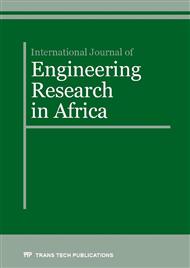p.35
p.44
p.57
p.64
p.71
p.85
p.103
p.112
p.124
Investigating the Calibration Curves for a Two Component Cutting Tool Lathe Dynamometer Using Finite Element Analysis
Abstract:
Calibration curves of a multi-component dynamometer is of essence in machining operations in a lathe machine as they serve to provide values of force and stress components for cutting tool development and optimization. In this study, finite element analysis has been used to obtain the deflection and stress response of a two component cutting tool lathe dynamometer, for turning operation, when the cutting tool is subjected to cutting and thrust forces from 98.1N to 686.7N (10 to 70kg-wts), at intervals of 98.1N(10kg-wt). By obtaining the governing equation, modeling the dynamometer assembly, defining boundary conditions, generating the assembly mesh, and simulating in Inventor Professional; horizontal and vertical components of deflection by the dynamometer were read off for three different loading scenarios. For these three loading scenarios, calibration plots by experiment compared with plots obtained from simulation by finite element analysis gave accuracies of 79%, 95%, 84% and 36%, 57%, 63% for vertical and horizontal deflections respectively. Also, plots of horizontal and vertical components of Von Mises stress against applied forces were obtained.
Info:
Periodical:
Pages:
71-84
Citation:
Online since:
June 2016
Price:
Сopyright:
© 2016 Trans Tech Publications Ltd. All Rights Reserved
Share:
Citation:


